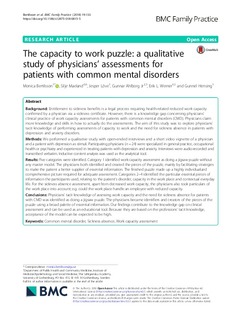| dc.contributor.author | Bertilsson, Monica | |
| dc.contributor.author | Mæland, Silje | |
| dc.contributor.author | Love, John Michael | |
| dc.contributor.author | Ahlborg, Gunnar | |
| dc.contributor.author | Werner, Erik Lønnmark | |
| dc.contributor.author | Hensing, Gunnel | |
| dc.coverage.spatial | Sweden | nb_NO |
| dc.date.accessioned | 2019-02-19T11:47:09Z | |
| dc.date.available | 2019-02-19T11:47:09Z | |
| dc.date.created | 2018-09-17T13:35:27Z | |
| dc.date.issued | 2018 | |
| dc.identifier.citation | Bertilsson, M., Maeland, S., Löve, J., Ahlborg, G., Werner, E. L., & Hensing, G. (2018). The capacity to work puzzle: A qualitative study of physicians’ assessments for patients with common mental disorders. BMC Family Practice, 19(1). | nb_NO |
| dc.identifier.issn | 1471-2296 | |
| dc.identifier.uri | http://hdl.handle.net/11250/2586226 | |
| dc.description.abstract | Background
Entitlement to sickness benefits is a legal process requiring health-related reduced work capacity confirmed by a physician via a sickness certificate. However, there is a knowledge gap concerning physicians’ clinical practice of work capacity assessments for patients with common mental disorders (CMD). Physicians claim more knowledge and skills in how to actually do the assessments. The aim of this study was to explore physicians’ tacit knowledge of performing assessments of capacity to work and the need for sickness absence in patients with depression and anxiety disorders.
Methods
We performed a qualitative study with open-ended interviews and a short video vignette of a physician and a patient with depression as stimuli. Participating physicians (n = 24) were specialized in general practice, occupational health or psychiatry and experienced in treating patients with depression and anxiety. Interviews were audio-recorded and transcribed verbatim. Inductive content analysis was used as the analytical tool.
Results
Five categories were identified. Category 1 identified work capacity assessment as doing a jigsaw puzzle without any master model. The physicians both identified and created the pieces of the puzzle, mainly by facilitating strategies to make the patient a better supplier of essential information. The finished puzzle made up a highly individualized comprehensive picture required for adequate assessment. Categories 2–4 identified the particular essential pieces of information the participants used, relating to the patient’s disorder, capacity in the work place and contextual everyday life. For the sickness absence assessment, apart from decreased work capacity, the physicians also took particulars of the work place into account; e.g. could the work place handle an employee with reduced capacity.
Conclusions
Physicians’ tacit knowledge of assessing work capacity and the need for sickness absence for patients with CMD was identified as doing a jigsaw puzzle. The physicians became identifiers and creators of the pieces of the puzzle using a broad palette of essential information. Our findings contribute to the knowledge gap on clinical assessment and can be used as an educational tool. Because they are based on the professions’ tacit knowledge, acceptance of the model can be expected to be high. | nb_NO |
| dc.language.iso | eng | nb_NO |
| dc.publisher | BioMed Central | nb_NO |
| dc.rights | Navngivelse 4.0 Internasjonal | * |
| dc.rights.uri | http://creativecommons.org/licenses/by/4.0/deed.no | * |
| dc.subject | common mental disorder | nb_NO |
| dc.subject | sickness absence | nb_NO |
| dc.subject | work capacity assessment | nb_NO |
| dc.title | The capacity to work puzzle: A qualitative study of physicians' assessments for patients with common mental disorders | nb_NO |
| dc.type | Journal article | nb_NO |
| dc.type | Peer reviewed | nb_NO |
| dc.description.version | publishedVersion | nb_NO |
| dc.rights.holder | © The Author(s). | nb_NO |
| dc.subject.nsi | VDP::Medisinske Fag: 700::Helsefag: 800 | nb_NO |
| dc.source.volume | 19 | nb_NO |
| dc.source.journal | BMC Family Practice | nb_NO |
| dc.source.issue | 1 | nb_NO |
| dc.identifier.doi | 10.1186/s12875-018-0815-5 | |
| dc.identifier.cristin | 1610164 | |
| cristin.unitcode | 203,3,11,0 | |
| cristin.unitname | Institutt for ergo/fysio/radio - Bergen | |
| cristin.ispublished | true | |
| cristin.fulltext | original | |
| cristin.qualitycode | 1 | |

